And nerds business automate
Hi, a recent article on Habré about how a programmer tried to sell , made me tell our little story about how we challenged the interfaces of the 90s and the entire automation of cafes, bars and restaurants in general, using modern technologies.
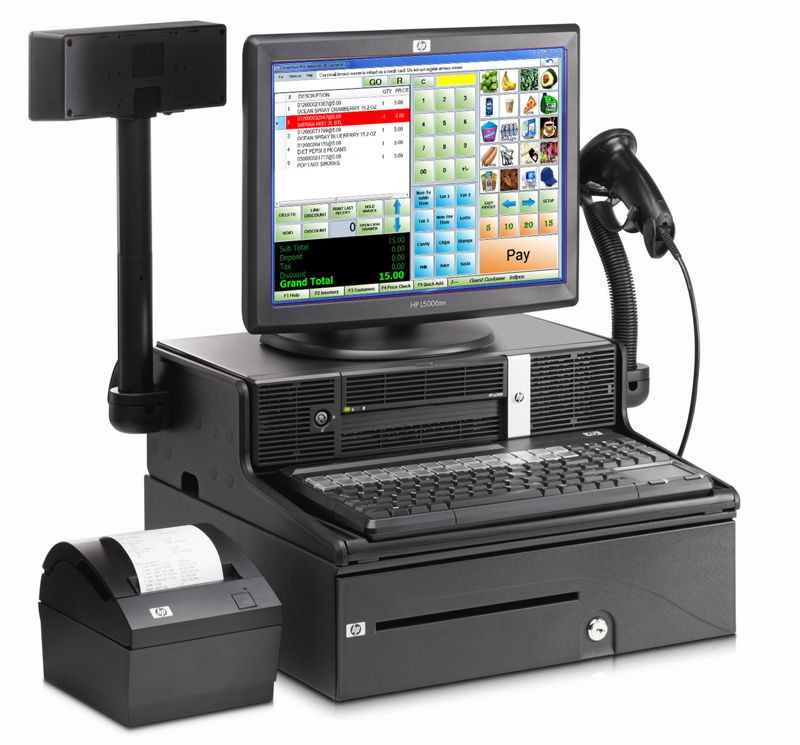
Below is a lot of revelation.
8 years ago I opened a studio, we made websites ... Two years ago, we thought about how to help visitors to establishments save time and money, and launched a single discount system. We, just a group of students, managed to launch a card in 5 cities of Ukraine and Russia and connect more than 300 selected institutions to it. Currently, there are more than 20,000 owners of such cards.
About a year after the launch, we thought about how else we can improve the work of establishments, reduce costs and increase the quality of service. And faced with a tangible barrier - a huge beast named "restaurant automation." You encounter it in cafes and restaurants when you make purchases in stores. This is a system that keeps a total record of everything that happens in the institution. Namely: procurement, tech. food cards, sales, write-offs, inventory, etc. Now in the CIS market, most of these systems are stationary solutions. Many of them were developed in the early 2000s, when cafes and restaurants had not yet heard about the Internet and wi-fi, so there was no talk about cloud technologies. Most of them look like MS Access 98, neither the hardware nor the interface is often adapted for touch,
Using the established contacts with institutions, we began to go around and ask them what kind of system they have, what problems they face, what they like, and what they would like to change. This helped us break the market and understand the needs.
We divided the institutions into 4 main types:
Having decided on the types of establishments, we decided to focus on the segment that seemed to us the most promising and in which there are no big players yet.
Immediately after the start, we wrote out for ourselves a short list of principles that our product should have:
As a result, we got a SaaS service for subscription based on the application for the iPad.
I’ll answer the most popular question right away: Why iPad and will there be an Android version?
The iPad was chosen because it has a good price / quality ratio, and is rather stable, but for Android it would be necessary to test the application for different versions, and what’s most unpleasant is the different screen resolution. We came to the conclusion that ± $ 50 will not solve anything for the owner and therefore we are not going to support Android, in any case in the near future.
Having spent several weeks combining all the ideas and creating a backlog, we started prototyping the interface.
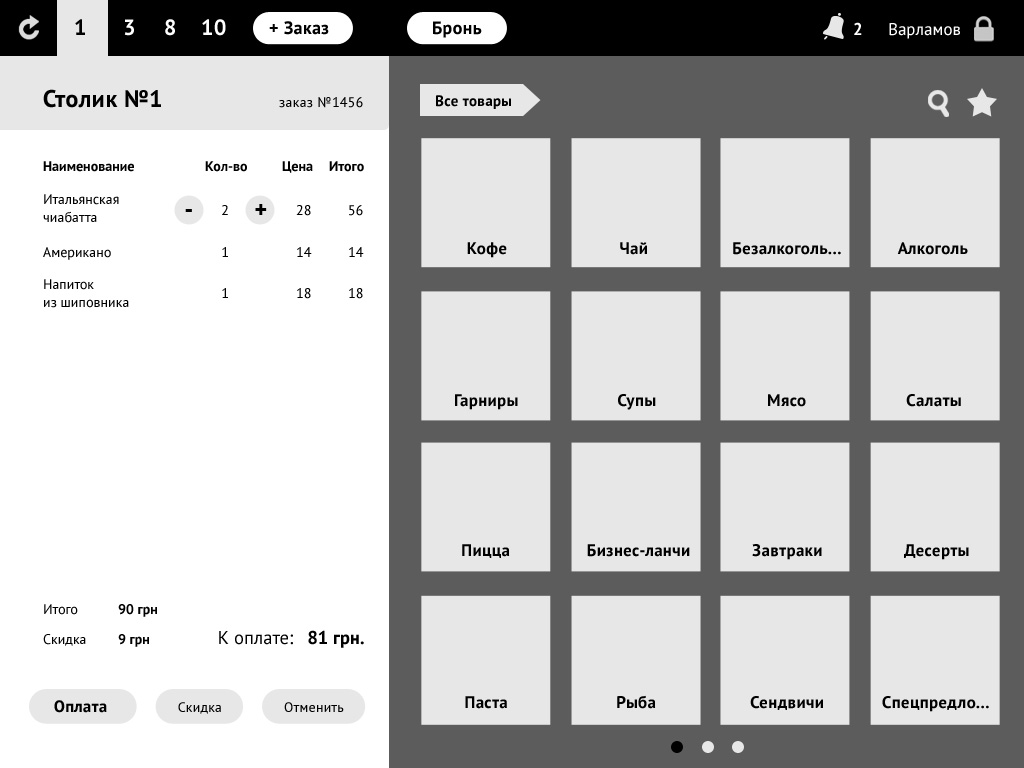
The first prototype was ready in a couple of days. We rushed past him with establishments, showing his waiters, administrators, owners, in order to get their feedback. In principle, this happens almost always when we change something in design. First, we give it to the waiters and cashiers for a weekly test, so that they can tell whether it really became easier and faster for them to accept and process orders. And only after that we roll out the update.
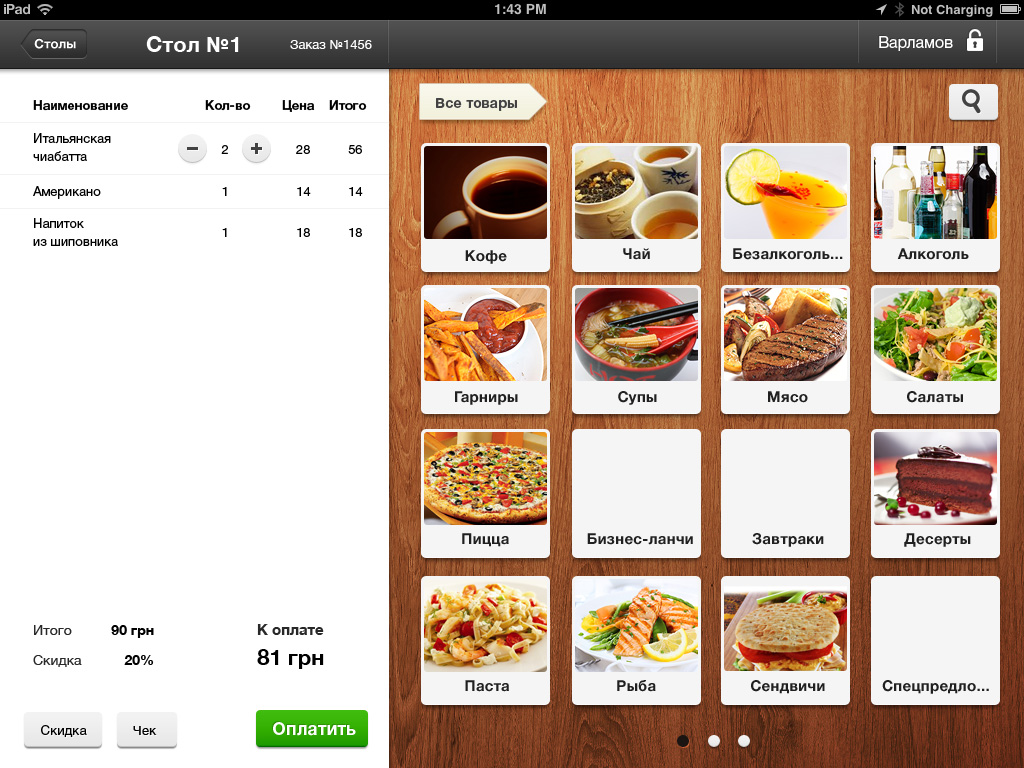
At this stage, we had the first angels. The guys from 908 believed in the project and helped us in six months to make the finished product from the prototype. We completely closed the studio and started our own project.
The first problems arose when we tried to teach the printer how to print from an iPad. It turns out that there are only 2 printer manufacturers who have the necessary libraries - Epson and Star. After we tried a dozen different models, we had to stop at Epson, because in Ukraine there is their official representative office, and work through it faster, especially in industrial volumes. We received the certificate and became the official distributor, wrote the application and posted it on the AppStore. Apple still didn’t want to post it; it demanded that we have official permission from Epson to use their open library. This is a long story connected with insanity and bureaucracy, I do not want to dwell on it. But in the end, we became the first in Ukraine to place a similar application in the Ukrainian AppStore.
In mid-November, we launched the registration. At the moment, we already have 20 client institutions. We have not yet spent a single cent on advertising and this is our 2nd article.
The project site - http://joinposter.com here you can see how everything works and read about the main differences from competitors.
You can download the free application and click on the demo access - https://itunes.apple.com/us/app/poster/id691098784
A couple of screenshots:
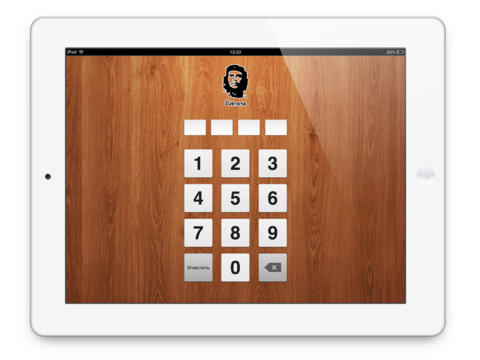
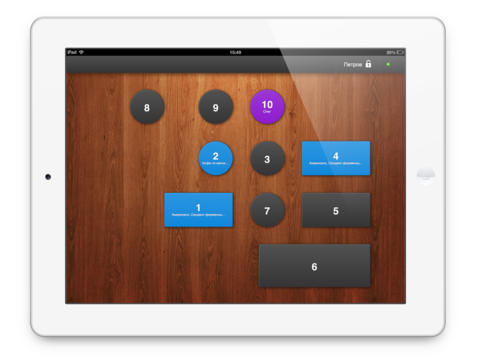
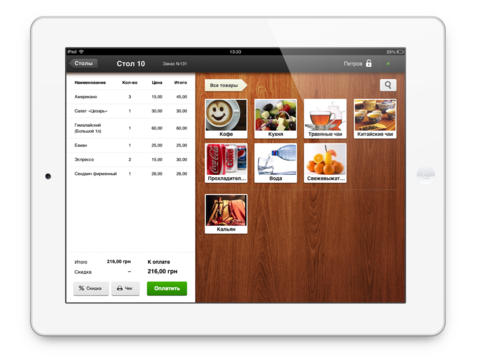
But here is how it looks in the institution
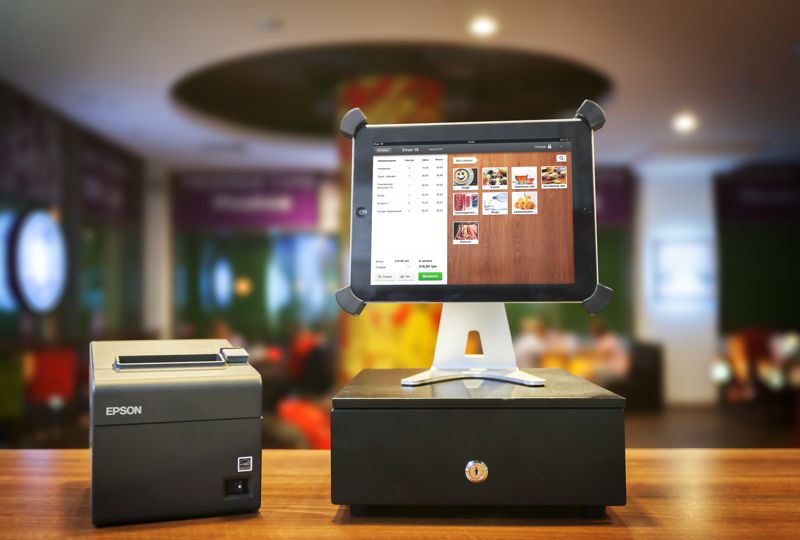
During these 2 years I have learned a lot for myself and learned a lot.
I understood why the cafe has such small portions :) I realized how hard it is, and at the same time it’s cool to work on my project. I realized that if you are a programmer, then there is no framework for you in any business. In one year, we were able to understand almost all the subtleties of the basic processes of an absolutely unfamiliar sphere for us and automate them. I realized how highly valued such people are. When I had to call Japan to Star or America to Epson, as soon as they found out that I was writing a program for their printers, they gave me a personal manager who helped us deal with the specification. It used to seem incredible to me, but you just need to pick up the phone and at least talk about what you are doing. I realized that investors are also people and there’s nothing wrong with them. I realized how hard it is to sell, even if your product is a cut above and the cheapest what exists in the market. All the same, it will have to be sold. I understood how important the team is, the goal we are moving towards, and the dream. The dream is to radically change the service in institutions for the better.
During this time we have come a long way. From two students, enlightened by the idea, to a company of 20 people, which already has its own mentors. And now, a couple of minutes before the corporate party, I wanted to share all this with you, dear Habrauser. I sometimes write very disgustingly and may lose my mental connection, but I hope my article will help you to decide and give strength and inspiration in the New Year in order to make the New Year unlike the previous one.
PS This is my first article, and it was pretty hard. I hope for understanding, constructive criticism and interesting questions so that I can understand what Habrauser is most interested in and tell about this in the next article.

Below is a lot of revelation.
Introduction
8 years ago I opened a studio, we made websites ... Two years ago, we thought about how to help visitors to establishments save time and money, and launched a single discount system. We, just a group of students, managed to launch a card in 5 cities of Ukraine and Russia and connect more than 300 selected institutions to it. Currently, there are more than 20,000 owners of such cards.
About a year after the launch, we thought about how else we can improve the work of establishments, reduce costs and increase the quality of service. And faced with a tangible barrier - a huge beast named "restaurant automation." You encounter it in cafes and restaurants when you make purchases in stores. This is a system that keeps a total record of everything that happens in the institution. Namely: procurement, tech. food cards, sales, write-offs, inventory, etc. Now in the CIS market, most of these systems are stationary solutions. Many of them were developed in the early 2000s, when cafes and restaurants had not yet heard about the Internet and wi-fi, so there was no talk about cloud technologies. Most of them look like MS Access 98, neither the hardware nor the interface is often adapted for touch,
Using the established contacts with institutions, we began to go around and ask them what kind of system they have, what problems they face, what they like, and what they would like to change. This helped us break the market and understand the needs.
Classification
We divided the institutions into 4 main types:
- a small cafe or bar (sometimes tea, hookah), usually up to 10 tables, all checks and documentation are manually on sheets
- average cafe or restaurant (using a budget solution or unlicensed software), usually one waiter's workplace, up to 50 tables
- a large cafe, restaurant, fast food (its own system, iiko and analogues), several cash desks, a network of establishments
- seasonal establishments
Having decided on the types of establishments, we decided to focus on the segment that seemed to us the most promising and in which there are no big players yet.
Principles
Immediately after the start, we wrote out for ourselves a short list of principles that our product should have:
- easy installation without instructions in a couple of minutes
- independent updates
- cloud security and storage
- mobility
- low price
As a result, we got a SaaS service for subscription based on the application for the iPad.
I’ll answer the most popular question right away: Why iPad and will there be an Android version?
The iPad was chosen because it has a good price / quality ratio, and is rather stable, but for Android it would be necessary to test the application for different versions, and what’s most unpleasant is the different screen resolution. We came to the conclusion that ± $ 50 will not solve anything for the owner and therefore we are not going to support Android, in any case in the near future.
Prototype
Having spent several weeks combining all the ideas and creating a backlog, we started prototyping the interface.

The first prototype was ready in a couple of days. We rushed past him with establishments, showing his waiters, administrators, owners, in order to get their feedback. In principle, this happens almost always when we change something in design. First, we give it to the waiters and cashiers for a weekly test, so that they can tell whether it really became easier and faster for them to accept and process orders. And only after that we roll out the update.

Investments
At this stage, we had the first angels. The guys from 908 believed in the project and helped us in six months to make the finished product from the prototype. We completely closed the studio and started our own project.
First problems
The first problems arose when we tried to teach the printer how to print from an iPad. It turns out that there are only 2 printer manufacturers who have the necessary libraries - Epson and Star. After we tried a dozen different models, we had to stop at Epson, because in Ukraine there is their official representative office, and work through it faster, especially in industrial volumes. We received the certificate and became the official distributor, wrote the application and posted it on the AppStore. Apple still didn’t want to post it; it demanded that we have official permission from Epson to use their open library. This is a long story connected with insanity and bureaucracy, I do not want to dwell on it. But in the end, we became the first in Ukraine to place a similar application in the Ukrainian AppStore.
Poster today
In mid-November, we launched the registration. At the moment, we already have 20 client institutions. We have not yet spent a single cent on advertising and this is our 2nd article.
The project site - http://joinposter.com here you can see how everything works and read about the main differences from competitors.
You can download the free application and click on the demo access - https://itunes.apple.com/us/app/poster/id691098784
A couple of screenshots:



But here is how it looks in the institution

conclusions
During these 2 years I have learned a lot for myself and learned a lot.
I understood why the cafe has such small portions :) I realized how hard it is, and at the same time it’s cool to work on my project. I realized that if you are a programmer, then there is no framework for you in any business. In one year, we were able to understand almost all the subtleties of the basic processes of an absolutely unfamiliar sphere for us and automate them. I realized how highly valued such people are. When I had to call Japan to Star or America to Epson, as soon as they found out that I was writing a program for their printers, they gave me a personal manager who helped us deal with the specification. It used to seem incredible to me, but you just need to pick up the phone and at least talk about what you are doing. I realized that investors are also people and there’s nothing wrong with them. I realized how hard it is to sell, even if your product is a cut above and the cheapest what exists in the market. All the same, it will have to be sold. I understood how important the team is, the goal we are moving towards, and the dream. The dream is to radically change the service in institutions for the better.
During this time we have come a long way. From two students, enlightened by the idea, to a company of 20 people, which already has its own mentors. And now, a couple of minutes before the corporate party, I wanted to share all this with you, dear Habrauser. I sometimes write very disgustingly and may lose my mental connection, but I hope my article will help you to decide and give strength and inspiration in the New Year in order to make the New Year unlike the previous one.
PS This is my first article, and it was pretty hard. I hope for understanding, constructive criticism and interesting questions so that I can understand what Habrauser is most interested in and tell about this in the next article.
